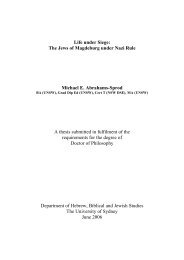Epimechus Dietz (Coleoptera: Curculionidae: Anthonomini)
Epimechus Dietz (Coleoptera: Curculionidae: Anthonomini)
Epimechus Dietz (Coleoptera: Curculionidae: Anthonomini)
Create successful ePaper yourself
Turn your PDF publications into a flip-book with our unique Google optimized e-Paper software.
108<br />
<strong>Epimechus</strong> mimicus closely resembles and has<br />
been confused with Magdalinops falli Clark and<br />
Burke (2001). Both species have dark integument<br />
broadly exposed between sparse, narrow scales, the<br />
rostrum long and slender, strongly curved, slightly<br />
more strongly so basally, and the antennal funiculus<br />
7-segmented. The Magdalinops is larger, however,<br />
has the rostrum broader at the base and more<br />
narrowed apically in lateral view, and lacks the<br />
apicomedian prominence of the median lobe of the<br />
aedeagus and the endophallic transfer apparatus<br />
exhibited by E. mimicus. Further, the tarsal claws<br />
of M. falli are longer and more widely divergent and<br />
have a small, acute basal prominence or slender<br />
tooth lacking in E. mimicus.<br />
Hatch's (1971:345) brief description of E. mimicus<br />
(as E. mimicrus) was apparently based on a<br />
specimen in the Hatch Collection (OSUO) with the<br />
label [<strong>Epimechus</strong>/ fir. mimicrus (sic.)/ <strong>Dietz</strong>/ Burke-<br />
1965]. The description, placed opposite that of E.<br />
alutaceus Hatch in a key, attributed to E. mimicus<br />
elytral vestiture "of inconspicuous decumbent setae,<br />
nearly colorless, sparse, usually separated by<br />
their own width or more and interspersed with or<br />
replaced by vestiture portions of which are so<br />
narrow as virtually to be setae", whereas E. alutaceus<br />
was described as having the vestiture "squamose,<br />
dense on undenuded areas where it is separated<br />
by the width of the scales or less, without<br />
setae among the scales." This specimen does in fact<br />
differ from the type of E. alutaceus in these characters<br />
and in addition has broader elytra and a<br />
stouter, more densely punctate rostrum. These<br />
features vary in specimens of E. alutaceus, however,<br />
and Hatch's E. mimicus is almost certainly<br />
conspecific with the type of that species. As discussed<br />
above, E. alutaceus belongs in Magdalinops.<br />
<strong>Epimechus</strong> adspersus <strong>Dietz</strong><br />
Figs. 9, 10, 26, 39<br />
<strong>Epimechus</strong> adspersus <strong>Dietz</strong> 1891:260. Lectotype (here<br />
designated). United States. California. [Cal] [W.<br />
G. <strong>Dietz</strong>/ CoIl.] [Type/ 2012] [<strong>Epimechus</strong>/ adspersus/<br />
<strong>Dietz</strong>] [LECTOTYPE/ <strong>Epimechus</strong>/ adspersus/<br />
Dtz./ des. H. R. Burke] (male, MCZC).<br />
Description. Integument black, broadly exposed<br />
between mostly non-imbricated, pallid, cretaceous<br />
scales. Length.: l.S-2.1mm. Width: 0.S-0.9mm.<br />
Head: vertex punctate, integument narrowly exposed<br />
between broad, non-imbricated, cretaceous<br />
Volume 15, No.2, June, 2001, INSECTA MUNDI<br />
scales. Rostrum: distinctly, evenly curved from<br />
base to apex; proximal portion rugose, with sparse,<br />
cretaceous scales; distal portion rugulose, punctate,<br />
glabrous. Antenna: funiculus with 6 segments.<br />
Prothorax: pronotum densely, coarsely punctate;<br />
dorsum with broad cretaceous scales laterally and<br />
medially, intermixed among narrower, fuscous<br />
scales lateromedially. Scutellum: slightly prominent,<br />
with dense cretaceous scales. Elytra: subparallel-sided<br />
in dorsal view, flattened on disc, rounded<br />
posteriorly in lateral view; striae distinctly impressed,<br />
each puncture with one minute, inconspicuous<br />
setae; interstriae subequal in width and slight<br />
convexity, with admixture of broad, cretaceous<br />
scales and narrower, fuscous scales; sutural interstriae<br />
not prominent. Pygidium: punctate. Abdomen:<br />
sterna 1-4 with narrow, pallid scales laterally,<br />
with sparser, narrower scales medially; sternum 5<br />
not impressed medially. Legs (Fig. 26): profemur<br />
moderately stout, unarmed; protibia narrow,<br />
straight, with broad inner-marginal prominence in<br />
basal 2\3, without pre apical prominence; protibial<br />
uncus short, slender, acute; metatibia of male with<br />
outer margin straight, inner margin broadly prominent<br />
in basal 2/3, with slight preapical convexity;<br />
metatibial mucro uncinate, acute, oblique in lateral<br />
view; metatibia of female slender, slightly expanded<br />
at extreme apex in lateral view, with inner<br />
margin slightly prominent in basal 112, slightly<br />
concave in apical 1/2, outer margin straight; metatibial<br />
mucro short, oblique, acute. Genitalia (Fig.<br />
39): median lobe of aedeagus slightly constricted<br />
subapically then abruptly narrowed and more gradually<br />
narrowed to bluntly rounded apex in dorsal<br />
view; endophallus minutely denticulate.<br />
Specimens examined. In addition to the lectotype<br />
from California, IS specimens of E. adspersus<br />
from the following localities were examined. United<br />
States. California. Monterey Co.: Carmel (6,<br />
CASC; "Bigelovia", 4, CASC; "greasewood", 3, CASC;<br />
"wax myrtle", 1, CASC); Monterey (1, MCZC). Santa<br />
Barbara Co.: Cuyama ("ex. Gutierrezia californica<br />
(DC). T&G (= G. bracteata Abrams) Sn Joaquin<br />
matchweed, 2, CDAE); Guadalupe (1, TAMU).<br />
Plant associations. Label data indicate that some<br />
adults of E. adspersus were collected on Gutierrezia<br />
californica (DC). T&G. (Asteraceae) and the other<br />
plants listed above.<br />
Remarks. The dark integument, broadly exposed<br />
on the pronotum and elytra between narrow, pallid
















